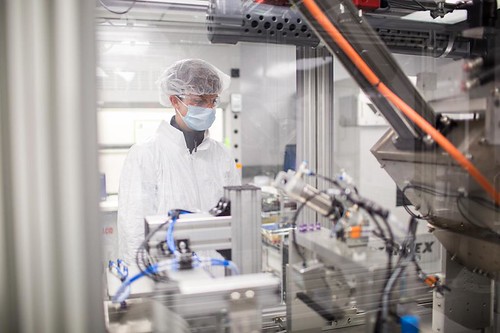美國麻省理工學院(MIT)和名為24M的衍生公司,共同翻新鋰電池的傳統製程,研發出一種介於液體及傳統固態間的新型半固膠狀電池。這項新發明不僅可以減半傳統充電電池的生產成本,同時提升效能及更便利回收。
 |
| 位於美國麻州的24M總部,研究人員正在研發新版鋰電池。圖片來源:24M。 |
生產流程重新來過 減少資源浪費
現今的製造固態鋰電池的流程自從發明20年後,不曾有大改變。舊的製造流程不僅步驟過多,效率也低。而新的鋰電池生產流程淘汰多餘步驟、提高製造效率、減低生產過程中,整體的資源浪費,也將生產成本砍半。
MIT材料科學系也是24M的創辦人之一的蔣業明(Yet-Ming Chiang)表示,不像傳統固態鋰電池,新型的半固膠狀電池彈性佳,利於多次彎曲折疊,或就算被子彈貫穿也無減其效能。「我們翻新流程設計。」蔣業明說道。
基於「流動的電池」概念,在流動電池的概念上,液體攜帶微小懸浮粒子組成兩電極,並進而把電流推進電池中。在新設計上,兩電極並非液態,而是由類似的半固膠狀微小懸浮粒子組成的。
電源周刊資深作者蔣業明闡述這項新方法說道,「新的設計簡化製作流程,讓電池更具彈性,抗損率也更佳。」蔣業明說,除簡化製作流程足以減半成本外,這項新技術能讓電池有更佳的彈性和抗損性。使用電池能更安全,提高耐久度。
擁多項專利 可做再生能源最大後盾
24M公司已從美國能源部等投資方募集了5千萬美元,而這套流程目前擁有8張專利,另外還有75張等待批准中。
目前公司最新展示的組裝生產線約製造了10,000顆電池。泰國一家石油公司和日本重機具製造商IHI Corp都在試驗用這種新型電池來製造產品。
起初,公司設計核心著重電網格設置,期能平均分散電力,且能當作風力和太陽能這類生產間歇電力的再生能源,作其後勤補給。不過蔣業明說,這項科技也適合運用在電動汽車這類重量和容量受到限制的電子裝置上。
An innovative approach to manufacturing lithium-ion batteries promises to halve the cost of the most widely used type of rechargeable batteries while boosting their performance and making them easier to recycle.
Developed by researchers at the Massachusetts Institute of Technology (MIT) and at a spinoff company called 24M, the new “semisolid” battery design is a hybrid between flow batteries and conventional solid ones.
Unlike conventional, solid lithium-ion batteries, the new semisolid cells are flexible enough to be bent and folded many times or even penetrated by bullets without affecting their performance, says co-inventor MIT’s Yet-Ming Chiang.
“We’ve reinvented the process,” says Dr. Chiang, the Kyocera Professor of Ceramics at MIT and a co-founder of 24M.
The current process for manufacturing lithium-ion batteries has changed little in the 20 years since the technology was invented. Chiang and co-inventor Dr. W. Craig Carter say the process is inefficient, with more steps and components than needed.
Their novel manufacturing process strips out the waste, speeds production and reduces the overall footprint to slash today’s lithium-ion battery costs by half.
The new process is based on a “flow battery” concept developed five years ago by Chiang and his colleagues.
In a flow battery, the electrodes are suspensions of tiny particles carried by a liquid and pumped through the battery’s compartments.
In the new version, while the electrode material does not flow, it is composed of a similar semisolid, colloidal suspension of particles.
This approach simplifies manufacturing, and makes batteries that are flexible and resistant to damage, says Chiang, who is senior author of a paper in the “Journal of Power Sources” describing the new process.
In addition to streamlining manufacturing enough to cut battery costs by half, Chiang says, the new system produces a battery that is more flexible and resilient. This should improve both safety and durability, he says.
The company has so far made about 10,000 batteries on its prototype assembly lines. They are undergoing testing by industrial partners, including an oil company in Thailand and Japanese heavy-equipment manufacturer IHI Corp.
The process has received eight patents and has 75 additional patents under review, while 24M has raised $50 million in financing from venture capital firms and a U.S. Department of Energy grant.
At first, the company is focusing on grid-scale installations, to help smooth out power loads and provide backup for renewable energy sources that produce intermittent output, such as wind and solar power.
But Chiang says the technology is also well suited to applications where weight and volume are limited, such as in electric vehicles.
※ 全文及圖片詳見:ENS







